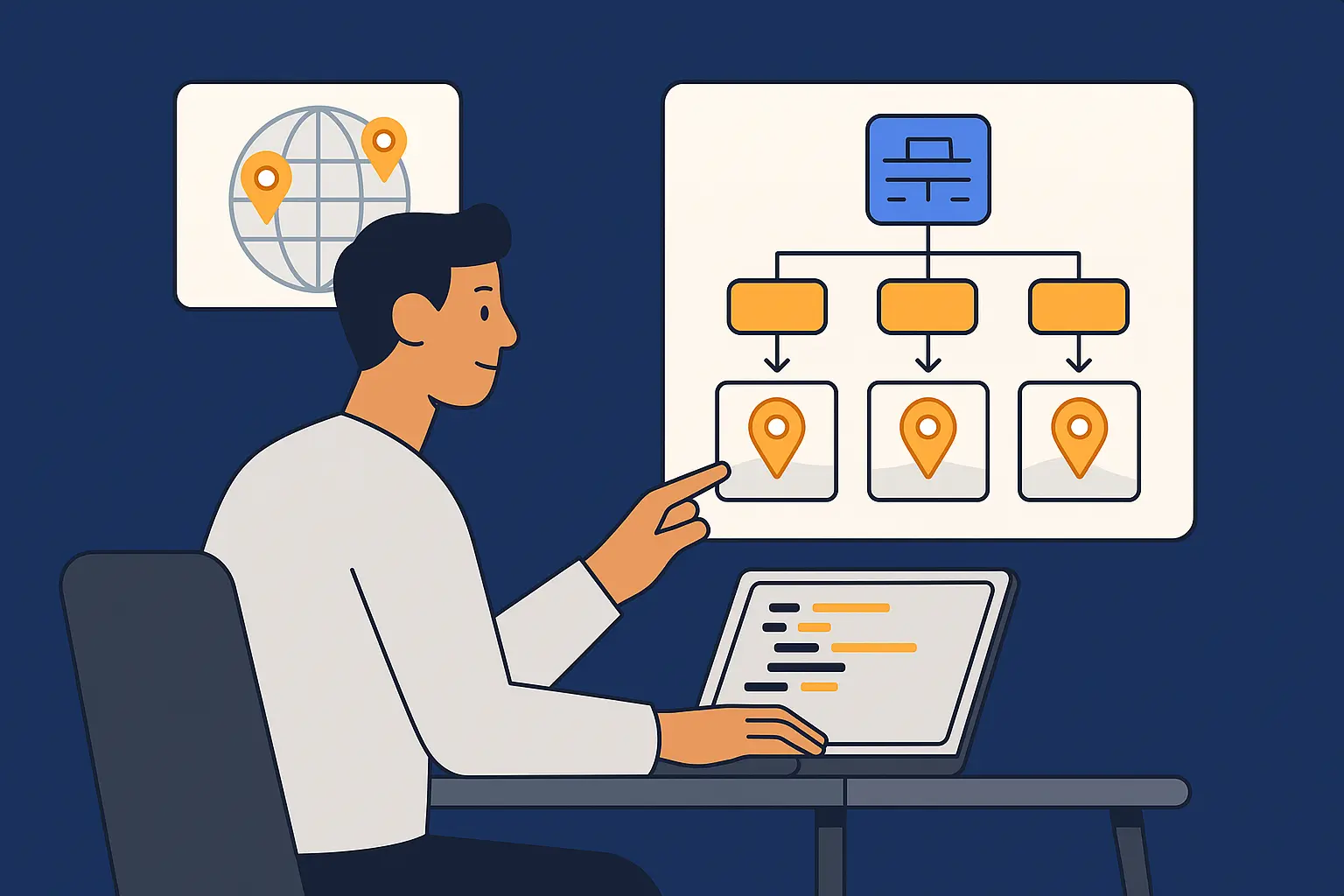Introduction

Regulatory pressure, customer expectations on speed, and the strategic need to enter new markets are colliding. For many executives, the blocker isn’t building the next feature—it’s ensuring the platform can store, process, and report on data in the right country or region without crippling engineering velocity or unit economics. That’s where region-aware application architecture comes in.
At CoreLine, we see a consistent gap: teams have strong product roadmaps but lack an actionable blueprint to meet data residency requirements while keeping performance high and costs controlled. This article offers a practical, executive-ready playbook for web and mobile leaders who need a region-by-region strategy that scales from MVP to enterprise application development.
What “region-aware” really means

Region-aware architecture is the deliberate design of your digital product so that:
- Sensitive data classes are stored and processed in the appropriate jurisdiction.
- Cross-border flows are explicit, minimized, and auditable.
- Latency‑critical experiences are served from the closest feasible edge.
- Costs remain predictable through standard patterns and automation.
It’s not just a compliance checkbox. Done well, it becomes a competitive advantage, unlocking new markets and enterprise deals while protecting gross margin.
When to prioritize it
- You’re expanding into the EU, UK, MENA, Brazil, India, or Australia where data localization rules and procurement due diligence are strict.
- You sell into regulated verticals (finance, health, public sector) where RFPs include residency and sovereignty requirements.
- Your customer base is globally distributed and you’re seeing performance drops or inconsistent analytics attribution.
For leadership, the “why now” is simple: region-aware decisions made during MVP development services set the ceiling for future revenue. Retrofitting later is dramatically more expensive.
A residency matrix your team can execute
Start with a Residency Matrix that your product managers, architects, and legal team can read in a single page. Keep it living, versioned, and tied to your release cadence.
- Data classes: PII, payments, health data, telemetry, session data, media, backups, logs, ML features.
- Residency rule: Must remain in-region, may transit for transient processing, free to replicate globally.
- Processing allowances: In-region only, EU+adequacy, global with SCCs/standard clauses.
- Retention: 30/90/365 days, legal hold flags, purge workflows.
- Access model: Break-glass procedures, role scopes, data minimization by service.
- Encryption posture: At rest (KMS/HSM region-bound), in transit (mTLS), key residency owner.
Product and compliance should co-own this artifact. Engineers implement; security and data governance validate.
Proven architecture patterns
1) Hub-and-spoke with in-region data hubs
- Spokes (regions) hold regulated data and user identifiers.
- The hub holds derived, non-sensitive aggregates and global configs.
- Use asynchronous pipelines with policy-aware routing to transform and anonymize data before it leaves a region.
Good for: organizations needing a single source of truth for reporting while respecting local storage constraints.
2) Sharded multi‑tenant by region
- Tenants are allocated to regional clusters (EU, US, APAC).
- Shared global services (feature flags, content, pricing) remain stateless and CDN‑accelerated.
- Inter‑region reads are limited to non-sensitive entities with cache TTLs.
Good for: platforms prioritizing predictable costs and simpler incident boundaries.
3) Data-mesh style domains with residency contracts
- Each domain (billing, identity, content, analytics) publishes data contracts, including residency guarantees.
- A policy engine enforces routing decisions based on contract metadata.
- Observability spans domains with redaction rules at the edge.
Good for: enterprises with multiple product lines and independent teams.
Identity and minimizing cross-border risk
- Region‑scoped identifiers: Store the global UUID separately from the region-specific subject ID. Services use the local subject ID by default.
- Token design: Embed region claims into tokens to prevent accidental out‑of‑region calls. Enforce in API gateways.
- Consent and preferences: Maintain consent ledgers per region; propagate only consent states needed by downstream services (not the user’s raw PII).
Analytics without breaking residency
- Server‑side event capture in‑region, followed by near‑real‑time anonymization (hashing, differential privacy, or tokenization) before export.
- Build regional feature stores for ML; ship models, not raw data. Models can be promoted globally if trained on de‑identified datasets with documented lineage.
- Define an “analytics portability ladder”:
- In‑region raw events,
- De‑identified aggregates shared with hub,
- Global KPIs with confidence intervals.
Observability, testing, and incident response
- Telemetry tiers:
- Tier 0 (PII‑free): Full global replication for reliability engineering.
- Tier 1 (metadata that could be sensitive when combined): Stored in-region with limited retention.
- Synthetic data at scale: Build de‑identified test datasets per region with shape parity. Automate drift checks when schemas evolve.
- Incident playbooks per region: Who is the DPO/owner? What regulators and customers require notification? Define MTTD/MTTR SLOs per region and test them quarterly.
Cost controls executives should demand
- FinOps tagging by region, environment, and service to track per‑market unit economics.
- Tiered storage: Hot in-region, warm in-region aggregates, cold global backups with encryption and key residency policies.
- Autoscaling with guardrails: Set per‑region max scale to protect budgets during unexpected spikes.
- Contract hygiene: Negotiate cloud egress discounts for policy‑approved cross‑region flows; prefer regional interconnects where available.
A phased adoption roadmap
Phase 0: Discovery (2–3 weeks)
- Residency Matrix draft, data inventory, top 20 flows, and current vendor map.
- Gap analysis aligned to target markets and near‑term releases.
Deliverables: executive readout, prioritized risk register, budgetary estimate.
Phase 1: Foundation (4–8 weeks)
- Regionized identity and secrets management.
- Policy‑aware API gateway with deny‑by‑default for cross‑region sensitive flows.
- Regional data stores for the top two sensitive classes (e.g., PII and payments).
Deliverables: reference architecture, IaC modules, playbooks.
Phase 2: Productization (8–16 weeks)
- Analytics portability ladder implemented.
- Regional feature stores and ML deployment pattern.
- Observability tiers with PII‑free global visibility.
Deliverables: end‑to‑end demo across two regions, performance and cost baselines.
Phase 3: Scale (ongoing)
- Add regions, extend contracts, automate audits, and integrate into your procurement responses and enterprise customer assurance packages.
Governance that doesn’t slow delivery
- Change control: any schema or contract change triggers automated checks against residency policies before merge.
- “Golden paths” for engineers: templates and scaffolds default to compliant choices; deviations require approval with logging.
- Quarterly business reviews: track market unlocks, deal velocity improvements, and unit economics per region.
KPIs executives can track
- Market unlocks: number of RFPs qualified where residency is a non-issue.
- Deal velocity: days shaved off security/procurement cycles.
- Performance: 95th percentile latency improvement in target regions.
- Cost efficiency: data egress per active user and storage per MAU by region.
- Risk posture: number of prevented out‑of‑region calls (as measured by gateway policies) and audit findings closed.
Common pitfalls (and how to avoid them)
- Treating residency as a storage problem only. Processing counts. Route compute thoughtfully and log what you forbid—not just what you allow.
- Over‑centralizing analytics. Push transformation in-region; promote only what’s safe and necessary.
- Hand‑rolled encryption schemes. Use managed KMS/HSM with region‑locked keys and clear key rotation policies.
- Ignoring developer experience. If region compliance adds more steps than a normal feature, teams will circumvent it. Make the safe path the fast path.
Event/Performer Details
- Event: CoreLine Executive Briefing — Region-Aware Application Architecture
- Format: 30‑minute on‑demand micro‑briefing + 15‑minute Q&A (virtual)
- Speakers: CoreLine Principal Consultant (Product), Lead Solutions Architect, and Engineering Manager
- Audience: CEOs, CTOs, CPOs, product directors, and compliance leaders exploring new markets
- City/Venue/Date: Online, On‑Demand, October 2025
Why You Shouldn’t Miss It
- Actionable framework you can hand to engineering this week, not a theoretical lecture.
- Concrete cost levers to keep residency from ballooning your cloud bill.
- Procurement‑ready language and artifacts to accelerate enterprise deals.
- Examples tailored to web apps, platforms, and mobile app consulting scenarios.
- Clarity on how to sequence residency work inside your existing roadmap.
Practical Information
- Who should own it: Product (policy and trade‑offs), Architecture (patterns and enforcement), Security (controls), Data (contracts and lineage), Finance (unit economics), Legal (jurisdiction mapping).
- Typical timeline: 2–3 weeks for Discovery, 1–2 months for Foundation in two regions, then iterative rollouts.
- Budgetary ranges:
- Discovery & Residency Matrix: typically $15k–$30k depending on footprint.
- Foundation implementation across two regions (baseline patterns, gateways, data stores): typically $60k–$120k.
- Productization (analytics ladder, ML feature stores, observability tiers): varies by scope; many teams plan $80k–$200k across a quarter.
Your actuals depend on stack, team size, and the number of markets.
- What we need to start: current architecture diagrams, data inventory (even if partial), top 20 data flows, current cloud regions/services, and upcoming market entries.
- Deliverables from CoreLine: Residency Matrix, reference architecture, IaC modules, enforcement policies, runbooks, cost/performance baselines, and a procurement response pack (security & residency answers you can reuse in RFPs).
Conclusion
Region-aware application architecture is not just a compliance exercise—it’s a growth and margin strategy. By codifying residency rules, standardizing patterns, and automating enforcement, you unlock new markets faster, negotiate with confidence, and keep your product experience fast everywhere it matters.
If you’re evaluating a custom web app development agency or planning the next step from MVP to an enterprise‑grade platform, CoreLine can help you design and implement a residency strategy that scales with your business.
Talk to CoreLine about a region‑aware architecture for your product



